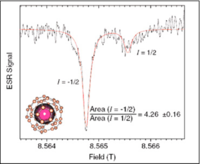Can Nuclear Qubits Point The Way?
Researchers from the University of Oxford and the National High Magnetic Field Laboratory at Florida State University have published “Efficient Dynamic Nuclear Polarization at High Magnetic Fields” in Physical Review Letters 98, 220501 (2007), which describes a technique for making molecules a thousand times more useful for quantum computing.
Qubits might very well be the vehicle for the next revolution in computing. Silicon technology has made computers increasingly fast, but some day the limits of what is possible with ones and zeros will be reached. One of the answers could be the transition from the “good-old” bit to the flashy qubit.
The “qu” in qubit stands for quantum, and one way to realise a qubit is to use tiny magnetic fields (called spins) that are associated with the nucleus and the electrons of atoms. In order to build a “quantum computer” from these spin-qubits, scientists first need to learn how to effectively manipulate these spins.
The authors have added to the quantum-computing technology roadmap by developing a new technique ‘‘polarization of nuclear spins enhanced by ENDOR’’ (PONSEE), which uses high magnetic fields and low temperatures to line up nuclear spins to a far greater extent than has been possible so far.
By applying this new technique for dynamic nuclear polarization involving simultaneous excitation of electronic and nuclear transitions, the researchers enhanced the nuclear polarization of the nitrogen nuclei in 15N@C60 by a factor of a thousand at a fixed temperature of 3 K and a magnetic field of 8.6 T, more than twice the maximum enhancement reported to date.
“N@C60 is a miraculous molecule,” said Andrew Briggs, Professor of Nanomaterials at the University of Oxford, and Director of the Quantum Information Processing Interdisciplinary Research Collaboration (www.qipirc.org). “Sixty carbon atoms are arranged like the vertices on a football, and then one nitrogen atom is placed in the middle. This enables us to do experiments as if on an isolated nitrogen atom, but in a solid state structure.”
The researchers needed to have both of the spins in the molecule pointing up at the beginning of the quantum computation. They made the electron spin point up by using a strong magnetic field over 150,000 times the strength of the Earth’s magnetic field, (8.6 tesla) and a low temperature (–270 Celsius or 3 kelvin), but still the nuclear spin had about a fifty-fifty chance of pointing up or down. The PONSEE technique transfers the alignment of the electron spins to the nuclear spins.
PONSEE could find applications beyond quantum information processing. It has drawn great interest from scientists working on nuclear magnetic resonance, because one thousand times more useful molecules could greatly shorten the time it takes to perform an NMR experiment.
The authors of the paper are Gavin W. Morley, Johan van Tol, Arzhang Ardavan, Kyriakos Porfyrakis, Jinying Zhang, and G. Andrew D. Briggs. This summary is adapted from
http://www.london-nano.com/content/newsevents/recentnews/nuclearqubitsjun07/



